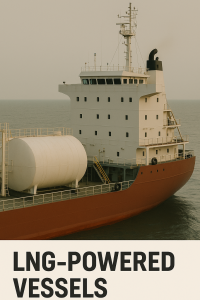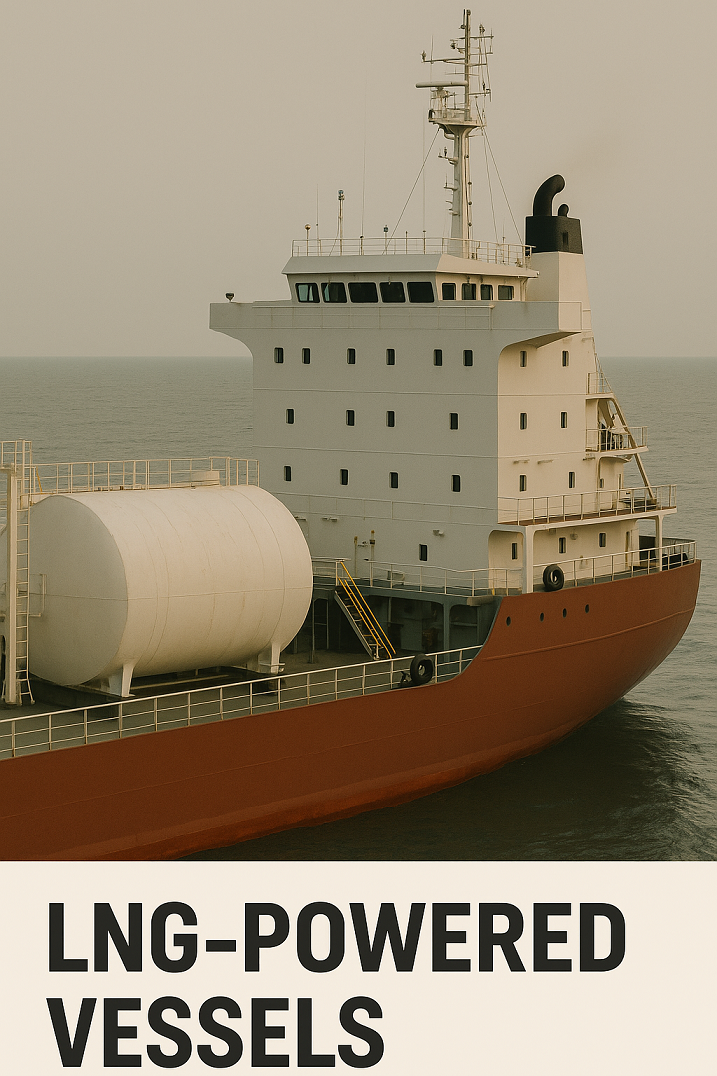Discover the top 12 noteworthy facts about LNG-powered vessels and how they are transforming maritime sustainability, operations, and global shipping economics. This in-depth guide explores innovations, challenges, and the future of LNG as marine fuel.

Why LNG-Powered Vessels Matter in Modern Maritime Operations
The maritime industry is undergoing a quiet revolution—and at the heart of it lies liquefied natural gas (LNG). As shipping faces mounting pressure to reduce greenhouse gas emissions and comply with international regulations, LNG emerges as one of the most promising transition fuels. Unlike heavy fuel oil (HFO), LNG burns cleaner, emitting significantly less sulphur oxides (SOx), nitrogen oxides (NOx), and particulate matter.
According to the International Maritime Organization (IMO), the maritime sector must reduce its total annual GHG emissions by at least 50% by 2050 compared to 2008 levels. LNG-powered vessels already represent a vital stepping stone toward this goal. As of 2024, there are over 450 LNG-fueled ships in operation, with more than 900 on order, according to data from DNV’s Alternative Fuels Insight platform.
Let’s explore the 12 most important things you need to know about LNG-powered vessels—from environmental benefits and technical innovations to real-world examples and the challenges that still lie ahead.
LNG Drastically Reduces Emissions
One of the most compelling reasons for switching to LNG is its impact on emissions. Compared to conventional marine fuels, LNG can reduce:
- SOx emissions by nearly 100%
- NOx by up to 85%
- Particulate matter by about 98%
- CO2 emissions by around 20%, depending on engine design
These figures are cited in reports by the European Maritime Safety Agency (EMSA) and Wärtsilä, a leading engine manufacturer. While LNG is not entirely carbon-free, it is a major improvement over traditional marine fuels and aligns with the IMO’s MARPOL Annex VI emission control requirements.
LNG Vessels Enable Compliance with IMO 2020 and Beyond
The IMO 2020 Sulphur Cap, which limits sulphur content in marine fuels to 0.50% globally, was a turning point. LNG, with its near-zero sulphur content, easily complies without the need for scrubbers or fuel blending. Moreover, LNG engines also meet Tier III NOx emission standards in ECAs (Emission Control Areas).
Compliance advantage: LNG eliminates the need for scrubbers or VLSFO, simplifying fuel logistics for shipowners and operators.
Dual-Fuel Engines Offer Operational Flexibility
LNG-powered vessels typically use dual-fuel engines, which can switch between LNG and conventional fuels like marine diesel oil (MDO). This provides both flexibility and redundancy—important for long-haul voyages and regions where LNG bunkering is not yet available.
Manufacturers like MAN Energy Solutions and Wärtsilä have developed high-efficiency, low-pressure dual-fuel engines with advanced control systems, allowing safe, seamless transitions between fuels.
Global LNG Bunkering Infrastructure Is Expanding
While LNG infrastructure was once limited to specific ports, global bunkering capacity has grown rapidly. According to the International Gas Union (IGU) and S&P Global, over 180 ports now offer LNG bunkering or are developing the capability.
Notable ports with LNG bunkering:
- Rotterdam
- Singapore
- Busan
- Fujairah
- Yokohama
- Houston
Floating bunkering vessels, such as Gas Agility and Kairos, are also helping meet the demand for ship-to-ship LNG fuel delivery.
LNG Reduces Engine Wear and Maintenance
Compared to heavy fuel oil, LNG burns cleaner and produces less engine residue. This results in reduced wear on pistons, cylinder liners, and exhaust systems. Over time, this can lower maintenance costs and extend engine life.
According to Lloyd’s Register‘s technical assessments, LNG-powered engines show reduced ash deposits and improved combustion stability, especially in four-stroke auxiliary engines.
Methane Slip Remains a Technical Challenge
Despite its benefits, LNG is not perfect. One concern is methane slip — the unburned methane released during combustion. Since methane is a potent greenhouse gas (28–36 times more powerful than CO2 over 100 years), its escape can undermine LNG’s climate advantage.
Engine manufacturers are working on solutions, such as:
- Exhaust gas recirculation
- Improved engine control strategies
- After-treatment catalysts (still under development)
The IMO’s GHG Strategy (2023 revision) encourages lifecycle GHG evaluations, which will likely factor in methane slip going forward.
Cold Energy Recovery Enhances Efficiency
LNG must be stored at around -162°C, and this cryogenic property can be harnessed for auxiliary systems. Cold energy recovery involves using LNG’s low temperature to chill air conditioning systems or produce inert gas. This boosts overall energy efficiency.
Example: Onboard LNG re-gasification systems can recover cold energy to generate nitrogen for tankers transporting flammable cargo.
LNG Supports Arctic and Polar Navigation
LNG-fueled ice-class vessels are becoming more common, especially in Arctic shipping lanes. Clean-burning LNG minimizes black carbon emissions, which are especially harmful in polar regions as they accelerate ice melt.
Case in point: The “Christophe de Margerie”, a Russian LNG carrier built for Arctic operations, successfully completed voyages through the Northern Sea Route with LNG propulsion, reducing emissions in this fragile ecosystem.
More Cruise Ships Are Switching to LNG
The cruise industry is also embracing LNG. Companies like Carnival Corporation, MSC Cruises, and Royal Caribbean have launched LNG-powered vessels, such as:
- AIDAnova (Carnival)
- MSC World Europa (MSC Cruises)
- Icon of the Seas (Royal Caribbean, launching 2024)
These ships reduce port emissions significantly, improving air quality in popular tourist destinations like Venice or Barcelona.
LNG Tank Design Requires Specialized Engineering
LNG storage tanks on ships are highly specialized. They are typically:
- Type C cylindrical tanks for smaller vessels
- Membrane tanks (such as GTT Mark III or NO96) for large LNG carriers
These tanks must withstand extreme cold, prevent leakage, and minimize boil-off gas (BOG), which is often re-liquefied or burned in the engine.
Safety systems include:
- Double-walled insulation
- Gas detection sensors
- Pressure relief systems
Life Cycle Analysis Is Becoming Industry Standard
Shipowners are increasingly turning to life cycle analysis (LCA) to measure the environmental performance of LNG vessels. This means considering not just tank-to-wake emissions, but also upstream activities like extraction, liquefaction, and transport.
As recommended by the World Bank and UNCTAD, LCA helps shipowners make informed decisions about alternative fuels and align with EU Fit for 55 and IMO decarbonization pathways.
LNG Is a Gateway to Future Fuels
LNG infrastructure and dual-fuel engines are often considered “methane pathway ready” or even ammonia-ready, allowing for future adaptation. Synthetic methane or bio-LNG can be blended with fossil LNG to reduce lifecycle emissions.
DNV’s Maritime Forecast to 2050 suggests that LNG will play a transitional role, paving the way for zero-carbon fuels like hydrogen, ammonia, or methanol.
Case Studies and Real-World Applications
TotalEnergies and CMA CGM: In 2021, CMA CGM partnered with TotalEnergies to fuel nine 23,000 TEU container ships with LNG. This collaboration marked a major shift in container shipping, achieving lower emissions and improved operational performance.
Shell and Q-LNG: Shell’s charter of the LNG bunkering barge Q-LNG 4000 enabled North America’s first LNG bunkering along the Gulf Coast.
Japanese LNG Ferries: The MOL-operated Sunflower Kurenai became one of Japan’s first LNG-powered ferries in 2023, showcasing the technology’s spread beyond tankers and cruise ships.
Frequently Asked Questions
Is LNG the best marine fuel for the future?
LNG is a transitional fuel. It significantly reduces air pollution and GHGs, but challenges like methane slip and limited carbon neutrality suggest future fuels (e.g., ammonia or hydrogen) may eventually take over.
How safe are LNG-powered ships?
Very safe when designed and operated properly. IMO’s IGC Code and classification society rules ensure stringent safety standards for LNG containment and handling.
What are the main costs involved in switching to LNG?
High initial investment in dual-fuel engines, LNG tanks, and bunkering infrastructure. However, long-term savings may arise from lower fuel costs and regulatory compliance.
Can LNG-powered ships use renewable fuels?
Yes. Bio-LNG and synthetic methane are already being trialed. Ships with dual-fuel engines can be upgraded to use blends.
How does LNG compare to scrubbers and VLSFO?
LNG provides cleaner combustion without added equipment like scrubbers. VLSFO, though compliant with IMO 2020, still emits more NOx and particulates than LNG.
Will LNG ships still be relevant after 2050?
Possibly. Ships built today may still operate in 2050, so retrofitting for new fuels or using carbon-neutral LNG blends could extend their relevance.
Conclusion: Charting a Cleaner Course with LNG
LNG-powered vessels are no longer just experimental—they are mainstream. With tangible benefits in emissions reduction, fuel efficiency, and regulatory compliance, LNG is helping the shipping industry take meaningful steps toward sustainability. While not the ultimate solution to maritime decarbonization, LNG represents a crucial bridge to future fuels and technologies.
From giant cruise ships to Arctic tankers, the versatility and growing infrastructure of LNG are shaping the industry’s next chapter. For maritime professionals, students, and stakeholders, understanding the capabilities and limitations of LNG is essential for navigating the complex journey ahead.
References
- DNV. (2024). Alternative Fuels Insight Platform. https://www.dnv.com
- IMO. (2023). GHG Reduction Strategy. https://www.imo.org
- European Maritime Safety Agency (EMSA). (2022). LNG as Fuel Report. https://www.emsa.europa.eu
- Lloyd’s Register. (2023). LNG Bunkering Safety & Risk Report. https://www.lr.org
- Wärtsilä. (2023). White Paper: LNG Engines & Emissions. https://www.wartsila.com
- S&P Global. (2024). LNG Marine Fuel Market Report. https://www.spglobal.com
- World Bank. (2021). Decarbonizing Maritime Transport. https://www.worldbank.org
- UNCTAD. (2023). Review of Maritime Transport. https://unctad.org

